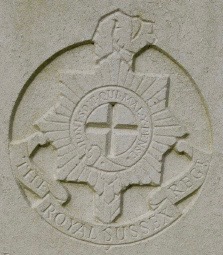William was born in Lewes in 1895, the eldest son of Harry George and Frances (Fanny) West, nee Page. His father was a bargeman and the family lived near the river. In 1901 they lived at the back of 43 South Street. Harry died in 1908 and the family seem to have fallen on hard times.
By 1911 William’s mother and sister were in the workhouse at East Chiltington, since the Lewes workhouse had closed in 1898. His younger brother was in the children’s house at St Anne’s. His elder sister was working as a domestic cook in Rodmell. William was living with his grandfather, a bargeman working for a coal merchant, at No. 1 Old Ship Cottages, at the back of South Street. He was listed as working as a drover.

Badge of the Royal Sussex Regiment
as depicted on a CWGC headstone
William’s army papers are no longer available to view but from the medal roll index cards we know that he first joined the 4th Battalion, the Royal Sussex Regiment and was numbered 5016. This was a TF Battalion and this number relates to an enlistment in late October 1916.
William was quickly transferred to the 7th, 8th, 9th or 10th Battalion as he was re-numbered G/16377. These battalions were numbered consecutively and this number was issued towards the end of 1916. It is most likely that William was placed initially in the 10th Battalion.
Although this was a general service battalion, hence the G as the prefix to William’s number, at that time it was based in Shoreham and used as a training battalion supplying reserves where needed.
It was not uncommon for men to be moved between battalions of the RSR, and having been issued with a general service number a man would have kept this number throughout his war service with the RSR. In William’s case he was later transferred to the 11th Battalion.
It is speculation when William was transferred to 11th Battalion and entered France, as their war diary does not note when they received new drafts of men. In the field the battalion was divided into four companies and William was probably placed in either B or D Company.
His obituary in the local paper says that he was killed as he left the trenches for a period of rest. The war diary entry for 13/02/1917, the date of his death, records that B and D company were in support of the Rifle Brigade’s raid in the Railway Wood Sector near Ypres. They were relieved the following day.
William is buried in the Vlamertinghe Military Cemetery in plot V J 10. He was entitled to the War and Victory medals and these would have been sent to his mother who was then living at 5 Castle Banks.
John is remembered on the St John sub Castro Memorial, the Lewes War Memorial and the RSR roll of honour kept in St George’s chapel in Chichester cathedral.




No Comments
Add a comment about this page